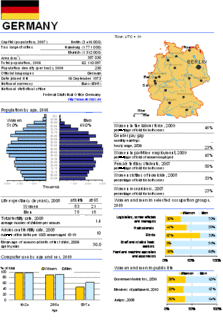
The economy of the United States is a highly developed market economy. It is the world's largest economy by nominal GDP and net wealth and the second-largest by purchasing power parity (PPP) behind China. It had the world's ninth-highest per capita GDP (nominal) and the fifteenth-highest per capita GDP (PPP) in 2021. The United States has the most technologically powerful and innovative economy in the world. Its firms are at or near the forefront in technological advances, especially in artificial intelligence, computers, pharmaceuticals, and medical, aerospace, and military equipment. The U.S. dollar is the currency most used in international transactions and is the world's foremost reserve currency, backed by its economy, its military, the petrodollar system and its linked eurodollar and large U.S. treasuries market. Several countries use it as their official currency and in others it is the de facto currency. The largest U.S. trading partners are China, the European Union, Canada, Mexico, India, Japan, South Korea, the United Kingdom, and Taiwan. The U.S. is the world's largest importer and the second-largest exporter. It has free trade agreements with several countries, including the USMCA, Australia, South Korea, Israel and several others that are in effect or under negotiation.

The United States Census Bureau (USCB), officially the Bureau of the Census, is a principal agency of the U.S. Federal Statistical System, responsible for producing data about the American people and economy. The Census Bureau is part of the U.S. Department of Commerce and its director is appointed by the President of the United States.

The North American Industry Classification System or NAICS is a classification of business establishments by type of economic activity. It is used by government and business in Canada, Mexico, and the United States of America. It has largely replaced the older Standard Industrial Classification (SIC) system, except in some government agencies, such as the U.S. Securities and Exchange Commission (SEC).
The Standard Industrial Classification (SIC) is a system for classifying industries by a four-digit code. Established in the United States in 1937, it is used by government agencies to classify industry areas. The SIC system is also used by agencies in other countries, e.g., by the United Kingdom's Companies House.

The United States had an official resident population of 331,449,281 on April 1, 2020, according to the U.S. Census Bureau. This figure includes the 50 states and the District of Columbia but excludes the population of five unincorporated U.S. territories as well as several minor island possessions. The United States is the third most populous country in the world. The Census Bureau showed a population increase of 0.8% for the twelve-month period ending in July 2012. Though high by industrialized country standards, this is below the world average annual rate of 1.1%. The total fertility rate in the United States estimated for 2020 is 1.638 children per woman, which is below the replacement fertility rate of approximately 2.1.
A violent crime, violent felony, crime of violence or crime of a violent nature is a crime in which an offender or perpetrator uses or threatens to use harmful force upon a victim. This entails both crimes in which the violent act is the objective, such as murder, assault, rape and assassination, as well as crimes in which violence is used as a method of coercion or show of force, such as robbery, extortion and terrorism. Violent crimes may, or may not, be committed with weapons. Depending on the jurisdiction, violent crimes may regarded with varying severities from homicide to harassment.

The American Community Survey (ACS) is a demographics survey program conducted by the U.S. Census Bureau. It regularly gathers information previously contained only in the long form of the decennial census, such as ancestry, citizenship, educational attainment, income, language proficiency, migration, disability, employment, and housing characteristics. These data are used by many public-sector, private-sector, and not-for-profit stakeholders to allocate funding, track shifting demographics, plan for emergencies, and learn about local communities. Sent to approximately 295,000 addresses monthly, it is the largest household survey that the Census Bureau administers.

Politicians and pundits frequently refer to the ability of the President of the United States to "create jobs" in the U.S. during his term in office. The numbers are most often seen during the election season or in regard to a President's economic legacy. The numbers typically used and most frequently cited by economists are total nonfarm payroll employment numbers as collected by the Bureau of Labor Statistics on a monthly and annual basis. The BLS also provides numbers for private-sector non-farm employment and other subsets of the aggregate.

Nonfarm payroll employment is a compiled name for goods, construction and manufacturing companies in the US. It does not include farm workers, private household employees, or non-profit organization employees.
A FIRE economy is any economy based primarily on the finance, insurance, and real estate sectors. Finance, insurance, and real estate are United States Census Bureau classifications. Barry Popik describes some early uses as far back as 1982. Since 2008, the term has been commonly used by Michael Hudson and Eric Janszen. It is New York City's largest industry and a prominent part of the service industry in the United States overall economy and other Western developed countries.

Official statistics are statistics published by government agencies or other public bodies such as international organizations as a public good. They provide quantitative or qualitative information on all major areas of citizens' lives, such as economic and social development, living conditions, health, education, and the environment.
Industry classification or industry taxonomy is a type of economic taxonomy that classifies companies, organizations and traders into industrial groupings based on similar production processes, similar products, or similar behavior in financial markets.
This article includes a list of China's historical gross domestic product (GDP) values, the market value of all final goods and services produced by a nation in a given year. The GDP dollar estimates presented here are either calculated at market or government official exchange rates (nominal), or derived from purchasing power parity (PPP) calculations. This article also includes historical GDP growth.

The International Labor Comparisons Program (ILC) of the U.S. Bureau of Labor Statistics (BLS) adjusts economic statistics to a common conceptual framework in order to make data comparable across countries. Its data can be used to evaluate the economic performance of one country relative to that of other countries and to assess international competitiveness.
The United States Economic Census is the U.S. federal government's official five-year measure of American business and the economy. It is conducted by the U.S. Census Bureau, and response is required by law. Forms go out to nearly 4 million businesses, including large, medium and small companies representing all U.S. locations and industries. Respondents are asked to provide a range of operational and performance data for their companies. Trade associations, chambers of commerce, and businesses use information from the economic census for economic development, business decisions, and strategic planning purposes. The last Economic Census was conducted for the year ending December 2017.

A boat livery is a boathouse or dock on a lake or other body of water, where boats are let out for hire (rental), usually on an hourly, daily or weekly basis. Boats may be powered or sail craft or human powered like rowboats, paddleboats (pedalos) or inflatable boats. The primary use of the boats is recreational.

The economy of the Australian Capital Territory (ACT) is the fastest-growing, sixth biggest economy of Australia as of the end of the 2017-18 financial year. Since the introduction of its self-government status in 1989, and with few exceptions in 1992, 1996, and 2014, the ACT economy has exhibited positive growth at a 1991-2018 average of 3.17 percent per year. A vast majority of the economy is concentrated in Canberra, the capital city of Australia, and is composed primarily by service industries, particularly those related to the administration of federal and local government. Construction also contributes to an important part of the economy, boosted by large government-funded projects and an active residential market. In contrast to other Australian states and territories, primary sectors such as agriculture, forestry, and mining, represent a very small proportion of the economy (±1%). A negative balance of trade has characterised the ACT economy since 2012-13, with small goods trade and a growing service export industry comprised mainly by education and public administration services.


















